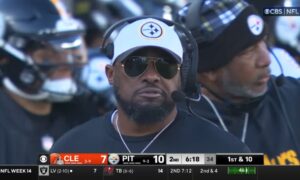When it comes to the Pittsburgh Steelers’ defense, no one is more valuable than T.J. Watt. Heck, when it comes to the Steelers period, no one is more valuable than him. The rare roster where the MVP isn’t the quarterback. As history has shown, without him, the defense shrinks. But Sunday night showed it can take a step back without Nick Herbig, too.
Exiting with a hamstring injury late in the third quarter, the Steelers’ defense shifted after that. While Watt remained on the field, Pittsburgh lacked a threat opposite him. The Cowboys could freely send all their attention to Watt, which they were doing before Herbig left anyway, but without the worry of the ‘1B guy’ beating them.
That’s shown in the numbers. Here are QB Dak Prescott and the Dallas Cowboys’ passing game stats along with the Steelers’ defensive pressure figures before and after Herbig’s injury.
| With Herbig | Without Herbig |
|---|---|
| 70.4 Completion Rate | 64.3 Completion Rate |
| 9.4 YPA | 6.4 YPA |
| 0 TDs | 2 TDs |
| 1 INT | 1 INT |
| 33.3 Pressure Rate | 14.3 Pressure Rate |
| 2 Sacks | 0 Sacks |
| 84.3 QB Rating | 92.3 QB Rating |
In some respects, the numbers aren’t much different. Dallas had a higher completion percentage and yards per attempt with Herbig in the lineup than when he was out of the game. Some of that can be attributed to Pittsburgh playing a “safer” defense late in the game after Herbig got hurt, Dallas throwing shorter passes as it marched downfield on two long touchdown drives.
The top number to key on is the pressure rate. With Herbig, the defense pressured Prescott one-third of the time. Without him, that number was cut by more than half. Perhaps some of the shorter passes played a factor but there were key moments where Prescott had plenty of time in the pocket, including on both of his touchdown passes. On his first one, Prescott had over 4.3 seconds in the pocket. On his second, he had 3.5 seconds from snap to throw and could’ve held the ball longer if he needed to.
When Alex Highsmith was healthy, he could play Robin to Watt’s Batman. When Highsmith went down, Herbig was able to fill a similar role and was dusting Cowboys rookie left tackle Tyler Guyton early before Guyton exited with an injury. Once Herbig went down, the team was left with DeMarvin Leal and Jeremiah Moon, big downgrades in pass-rush juice. And even Leal was lost in the fourth quarter, leaving a very tired Moon and Watt (Moon in his first game of the season after an ankle injury) to huff and puff through the rest of the game.
With Highsmith expected to miss another week and Herbig not looking likely to play Sunday, the Steelers will need a different game plan. One that requires them to blitz more than they have all season. No longer is the pure “rush four, drop seven” approach going to work until Highsmith and/or Herbig get back. For most of the year, Pittsburgh’s opted against blitzing, doing so just 21 percent of the time and even many of those were “green dogs” of linebackers rushing when their assignments stayed in to block. Compare that to last year when the Steelers blitzed 31.2 percent of the time. If that 21-percent number were to hold, it would be five points lower than their previous low blitz rate of 26 percent in 2021. A year in which Watt tied the NFL single-season sack record and Pittsburgh didn’t need to send numbers.
For the present, that’s going to have to change. Rushing four and dropping seven can’t be the default game plan anymore, at least not in base form. There are still ways to send creative and “safe” pressure without sending the house. Still, all that comes with additional risks and weak points in coverage for a unit struggling to play fundamental football. There’s always a trade-off but in Pittsburgh, pressure is paramount.
Point is, without Herbig and even with Watt, this defense has changed, and so will the Steelers’ game plan until their health improves.








